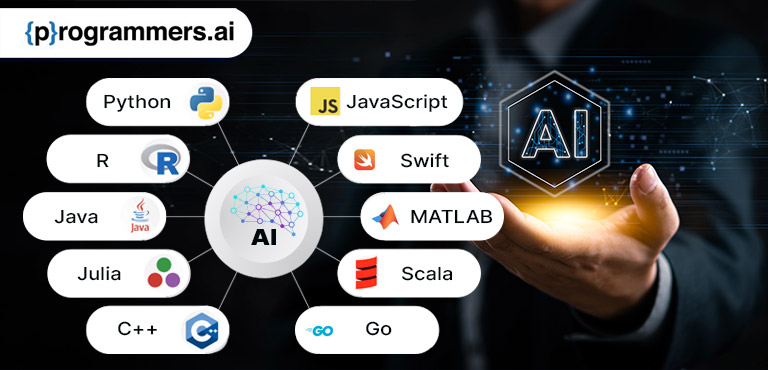The technological landscape is undergoing a revolution driven by Artificial Intelligence (AI). AI is transforming everything from facial recognition software in our smartphones to autonomous vehicles on the road. As AI continues to evolve, the AI programming languages become a crucial factor for developers. Choosing the right language can significantly impact the efficiency, performance, and overall success of your AI project.
This blog will provide a comprehensive overview of the top 10 AI programming languages in 2024. We’ll explore the strengths, weaknesses, and use cases of each language to help you make informed decisions for your AI development journey.
The Importance of AI Programming Languages
Selecting the right AI programming language is critical for several reasons. Different languages offer varying levels of:
- Ease of Use: Some languages are beginner-friendly, allowing rapid prototyping and experimentation.
- Performance: Certain languages excel in handling complex computations and large datasets, vital for resource-intensive AI tasks.
- Libraries and Frameworks: A rich ecosystem of libraries and frameworks provides pre-built tools and functionalities, accelerating development.
- Community Support: A large and active community offers valuable resources, tutorials, and troubleshooting assistance.
List of 10 Top Ai Programming Languages
Let’s delve into what makes these AI programming languages so widely used and their applications.
1. Python
Python easy-to-learn syntax and extensive collection of AI programming language libraries make it the perfect choice for both beginners and experienced developers venturing into AI. Companies can leverage Python’s rich ecosystem to streamline AI development services, building intelligent applications with powerful tools like TensorFlow and scikit-learn. This combination of user-friendliness and robust functionality solidifies Python’s position as a top choice for AI endeavors.
Popularity and Community Support:
Python boasts a massive and active community that contributes to a vast collection of libraries and frameworks specifically designed for AI.
Libraries and Frameworks:
TensorFlow, PyTorch, and scikit-learn are just a few examples of powerful Python libraries that empower developers to build complex AI models. These libraries handle tasks like data manipulation, machine learning algorithms, and deep learning architectures.
Use Cases in AI:
Python is incredibly versatile and finds application in various AI domains, including natural language processing, computer vision, and recommender systems.
2. R
R statistical analysis strength makes it a favorite for data scientists in AI. Specialized packages like tidyverse and caret streamline data manipulation, visualization, and machine learning tasks. Seamless integration with other data science tools empowers them to leverage the best of various environments for AI exploration and model building.
Statistical Analysis Capabilities:
R offers a wealth of built-in functions and packages for statistical analysis, a cornerstone of many AI projects.
Libraries specific to data science and AI:
Packages like tidyverse, caret, and xgboost provide specialized tools for data cleaning, machine learning model training, and model evaluation.
Integration with other tools:
R seamlessly integrates with other widely used data science tools like Python and visualization libraries like ggplot2, allowing for a smooth workflow.
3. Java
Java popularity in AI extends beyond its platform independence. Java offers robust AI libraries and frameworks like Deeplearning4j and WEKA, empowering developers to build and deploy complex AI models efficiently. This combination of portability, scalability, and powerful AI tools makes Java a compelling choice for developing enterprise-grade AI applications.
Platform independence:
Java’s “write once, run anywhere” philosophy ensures code portability across different operating systems, a significant advantage for large-scale deployments.
Performance in large-scale applications:
Java is known for its efficient memory management and ability to handle complex computations, crucial for resource-intensive AI tasks.
AI libraries and frameworks:
Frameworks like Deeplearning4j and WEKA provide Java developers with tools for building and deploying AI models.
4. Julia
Julia exceptional speed and focus on scientific computing make it ideal for computationally intensive AI tasks like deep learning. This, combined with its growing community and developing libraries like Flux and MLJ.jl, positions Julia as a promising language for the future of AI development.
Performance and speed:
Julia boasts impressive performance, often surpassing traditional languages like Python in terms of execution speed. This makes it ideal for computationally intensive AI tasks like deep learning.
Specific use cases in AI and machine learning:
Julia’s strengths lie in scientific computing and machine learning. Packages like Flux and MLJ.jl offer functionalities for building and training various AI models.
Growing community and libraries:
While the Julia community is smaller compared to established languages, it’s rapidly growing, with new libraries and frameworks constantly emerging.
5. C++
C++ empowers developers with unparalleled control over hardware resources, enabling the creation of highly optimized and efficient AI applications, especially for resource-constrained environments. This fine-grained control makes C++ a go-to choice for developing AI in embedded systems and robotics, where squeezing maximum performance out of the hardware is crucial.
Performance and control:
C++ offers unparalleled control over memory management and hardware resources, leading to highly optimized and efficient AI applications. This level of control allows developers to squeeze the most performance out of the underlying hardware, making it ideal for computationally intensive tasks.
Use in embedded systems and robotics:
C++’s performance makes it a go-to language for developing AI-powered systems with strict resource constraints, such as embedded systems and robotics. Imagine a self-driving car – critical decisions need to be made in real-time, and C++’s ability to optimize code for speed is essential for ensuring safe and efficient operation.
AI frameworks and libraries:
Frameworks like Eigen, which focuses on linear algebra operations, and Dlib, which provides tools for computer vision and machine learning, cater to the specific needs of AI development in C++. While not as extensive as the libraries available for Python, the C++ community has created powerful tools to address common AI challenges.
6. JavaScript
JavaScript transformation empowers developers to create intelligent features directly within web browsers, eliminating complex installations and enabling wider accessibility for AI-powered applications. Frameworks like TensorFlow.js bring the power of machine learning to the browser, further expanding the possibilities for web-based AI.
Use in web-based AI applications:
With the rise of web frameworks like TensorFlow.js and libraries like ml5js, JavaScript empowers developers to create intelligent applications directly in the browser. This eliminates the need for complex installations and allows for wider accessibility.
Libraries like TensorFlow.js:
TensorFlow.js brings the power of TensorFlow to the browser, enabling developers to train and run machine learning models directly in JavaScript.
Integration with other technologies:
JavaScript’s seamless integration with HTML, CSS, and web frameworks allows for the creation of interactive and user-friendly AI experiences.
7. Swift
Swift tight integration with Apple’s development tools like Core ML and Create ML empowers developers to build and deploy efficient machine learning models directly on Apple devices. This streamlines the development process and ensures optimal performance for AI applications on iPhones, iPads, and Macs.
Use in iOS development and AI applications:
AI programming languages like Swift are ideal for creating intelligent features within iOS applications, such as facial recognition or natural language processing.
Libraries and tools available:
Core ML and Create ML are powerful tools within the Apple development framework that enable developers to build and deploy machine learning models on Apple devices.
Performance considerations:
Swift is known for its speed and efficiency, making it suitable for developing AI applications that require real-time performance on Apple devices.
8. MATLAB
MATLAB excels in data visualization, allowing researchers to effectively explore and interpret the results of their AI models. This visual representation is crucial for understanding complex AI model behavior and guiding further development. Additionally, MATLAB offers a rich set of built-in functions specifically designed for tasks like signal processing, a critical area in various AI applications like image recognition and natural language processing.
Use in research and academia:
MATLAB’s built-in functions and toolboxes cater specifically to scientific computing and signal processing, making it a favorite among researchers exploring AI algorithms.
Built-in functions for AI and machine learning:
MATLAB offers a rich set of functions for tasks like data analysis, machine learning, and deep learning.
Visualization capabilities:
MATLAB excels in data visualization, allowing researchers to effectively explore and interpret the results of their AI models.
9. Scala
Scala, a functional AI programming language, is rising in popularity for its ability to handle massive datasets and complex data pipelines. This makes it a powerful tool for large-scale AI projects. Scala’s focus on code reusability and seamless integration with Apache Spark allows for efficient AI development.
Integration with big data tools like Apache Spark:
Scala seamlessly integrates with Apache Spark, a popular big data processing framework, making it well-suited for working with large datasets commonly encountered in AI projects.
Functional programming features:
Scala’s functional programming paradigm promotes code reusability and maintainability, leading to cleaner and more scalable AI applications.
Libraries for AI and machine learning:
Libraries like Apache MLlib and Deeplearning4j provide Scala developers with tools for building and deploying machine learning models.
10. Go
Go’s strengths extend beyond scalability. Its lightweight concurrency features, achieved through goroutines and channels, enable efficient handling of concurrent tasks often encountered in AI development. This allows AI applications to process data and perform computations in parallel, leading to significant performance improvements. Additionally, Go’s growing ecosystem of AI-specific libraries like GoLearn and DeepGo empowers developers to build and deploy machine learning models directly in Go, reducing the need to rely on external tools.
Performance and concurrency:
Go excels in handling concurrent tasks and efficient memory management, making it suitable for building large-scale AI systems that process data in real-time.
Use in scalable AI systems:
Go’s concurrency features enable developers to create distributed AI systems that can handle complex workloads efficiently.
Libraries and community support:
While the Go AI programming language community is still growing, libraries like GoLearn and DeepGo are emerging to provide tools for building AI models in Go.
How to choose an AI programming language
Selecting the right AI programming language hinges on your project’s specific needs and your team’s expertise. Consider the AI task, data size, and target platform. If your team is already familiar with Python’s clean syntax and vast libraries, it might be a great choice despite another language potentially being technically superior. Development speed is also a factor – Python allows for quicker prototyping. Remember, a large, active community like Python’s offers valuable resources.
Finally, consider language maturity – established options like Java provide stability, while newer languages may have fewer resources available. There’s no one-size-fits-all solution, so carefully weigh these factors to pick the language that empowers your AI project’s success.When choosing your AI programming language, aim for synergy between functionality and familiarity to maximize your project’s potential. Remember, the right AI language sets the foundation for innovation and efficiency in your development journey.
Conclusion
Navigating the world of AI programming languages in 2024 can feel like a daunting task, but each language offers something unique. Whether you’re drawn to Python’s user-friendliness, R’s statistical prowess, Java’s robustness, or the speed of Julia and Swift, there’s a perfect match for every AI project. JavaScript and Go shine in web and scalable systems, while MATLAB, Scala, and C++ cater to specialized needs in research, big data, and performance-intensive applications.
The right choice depends on your project and your team’s strengths. For personalized guidance and top-notch AI development services, consider partnering with Programmers.ai. Our experts can help you leverage the best tools and languages to bring your AI vision to life.






